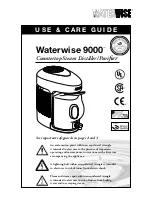
Page 7
ABOVE
FINISHED
SPACE?
OVERFLOW DRAIN LINE
ALWAYS RUN AN OVERFLOW DRAIN LINE. IF NOT POSSIBLE TO
ROUTE OVERFLOW DRAIN LINE, INSTALL LOW VOLTAGE
OVERFLOW SWITCH KIT. WIRE KIT TO SHUT DOWN
COMPRESSOR PER INSTRUCTIONS.
NO
YES
OEM CATALOG#
X3169
CLEAN OUT
VENT
PRESS IN
(DO NOT GLUE)
VENT MUST EXTEND
ABOVE HEIGHT OF
COIL DRAIN PAN BY
TWO INCHES
1” X 3/4” X 3/4”
REDUCING
TEE WITH
PLUG
OEM CATALOG
NUMBERS* P-TRAP
49P66, J-TRAP #
91P90 OR ANY PVC
SCH 40 P- OR
J-TRAP 3/4”
OVERFLOW
DRAIN
OPTIONAL
SAFETY
PAN
COIL DRAIN PAN
WHEN A COIL IS LOCATED ABOVE A FINISHED SPACE, A 3/4” SECONDARY DRAIN LINE
MUST BE:
●
CONNECTED TO SECONDARY DRAIN PAN
OR
●
CONNECTED TO THE OVERFLOW DRAIN OUTLET OF THE AIR HANDLER DRAIN PAN.
TRAPS MUST BE DEEP ENOUGH TO OFFSET MAXIMUM STATIC DIFFERENCES —
GENERALLY, TWO INCHES.
DRAIN LINE SHOULD
SLOPE A MINIMUM OF
ONE INCH PER 10 FT.
NOTE
— WHEN A AIR HANDLER IS LOCATED ABOVE A FINISHED SPACE THE SECONDARY
DRAIN PAN MUST HAVE A LARGER FOOTPRINT THAN THE AIR HANDLER.
MAIN
DRAIN
TO APPROVED
DRAIN
FOR NEGATIVE PRESSURE COILS (BLOWER
AFTER COIL) TRAPS ARE REQUIRED ON ALL
DRAIN LINES CONNECTED TO COIL.
COMPACT OVERFLOW SWITCH WITH 3/4” FEMALE SLIP INLET
AND MALE ADAPTER, TWO PART DESIGN FOR USE WHERE
OBSTRUCTIONS PREVENT DIRECT THREADING
SECONDARY
DRAIN PAN
2”
(51MM)
TRAP DEPTH
*OEM CATALOG # P-TRAP 49P66 REQUIRES A LARGER INSTALLATION SPACE THAN THE J-TRAP 91P90.
FIGURE 8
. Typical Main and Overflow Drain Installations
Blower Speed Selection
Proper air volume must be provided over the evaporator
coil. Select a blower motor speed tap that will provide 400
± 50 CFM per 12,000 Btuh of cooling capacity (wet coil).
A static pressure reading must be taken to see if the pres-
sure drop falls within the proper range.
To ensure accuracy, static pressure must be read from the
air entry side of the coil to the air exit side of the coil. See
figure 9 for an example to obtain an accurate reading.
LEFT-HAND AIR DISCHARGE (TOP VIEW)
SUPPLY AIR UNIT FRONT
SUPPLY AIR UNIT REAR
AIR
FLOW
TEST HOLE 1
TEST HOLE
2
SUPPLY
AIR DUCT
RETURN AIR
DUCT
FIGURE 9. Static Pressure Test
CAUTION
Take care when drilling test holes into the furnace flange
and the duct. Drill holes away from refrigerant piping.
Test holes should be drilled where specified in order to
avoid unit damage.
1 - Drill a 5/16" test hole in the coil case 1" from the
furnace flange (test hole 1, figure 9).
2 - Drill a 5/16" test hole into the supply air duct (test
hole 2, figure 9).
3 - Connect the zero end of the draft gauge scale to the
furnace end of the coil. Insert the hoses so that 1/4"
extends inside the duct or end seal. Seal around
holes with Permagum.
4 - Turn on electrical power to the furnace and set the
thermostat to initiate a cooling demand.
5 - Table 2 lists the range of air volumes and equivalent
draft gauge readings for this unit. Observe the draft
gauge reading. If the reading is below the required
air volume, increase the blower speed; if the reading
is above the required air volume, decrease the
blower speed. Refer to the furnace wiring diagram
for blower speed settings.


























